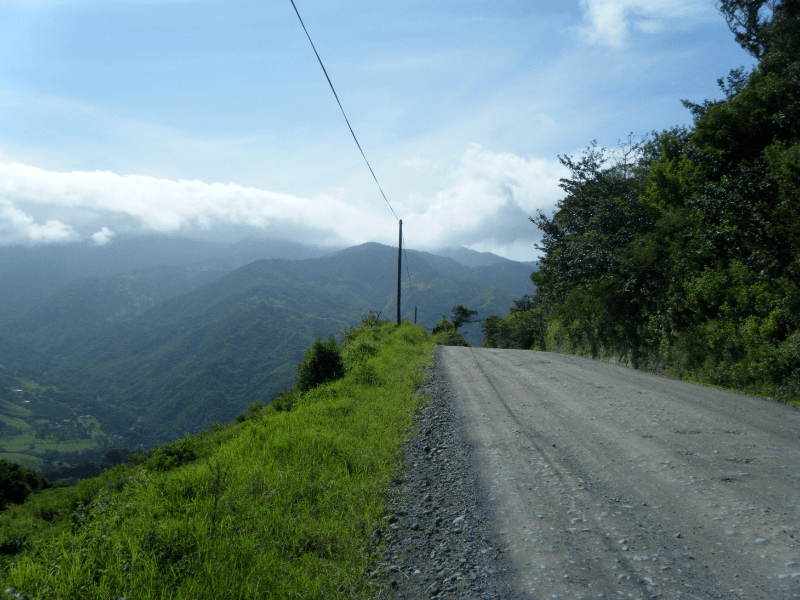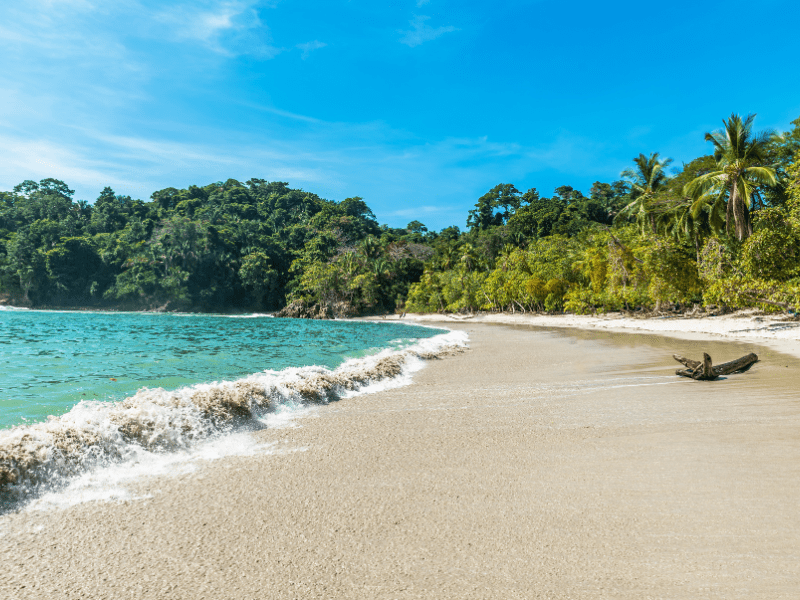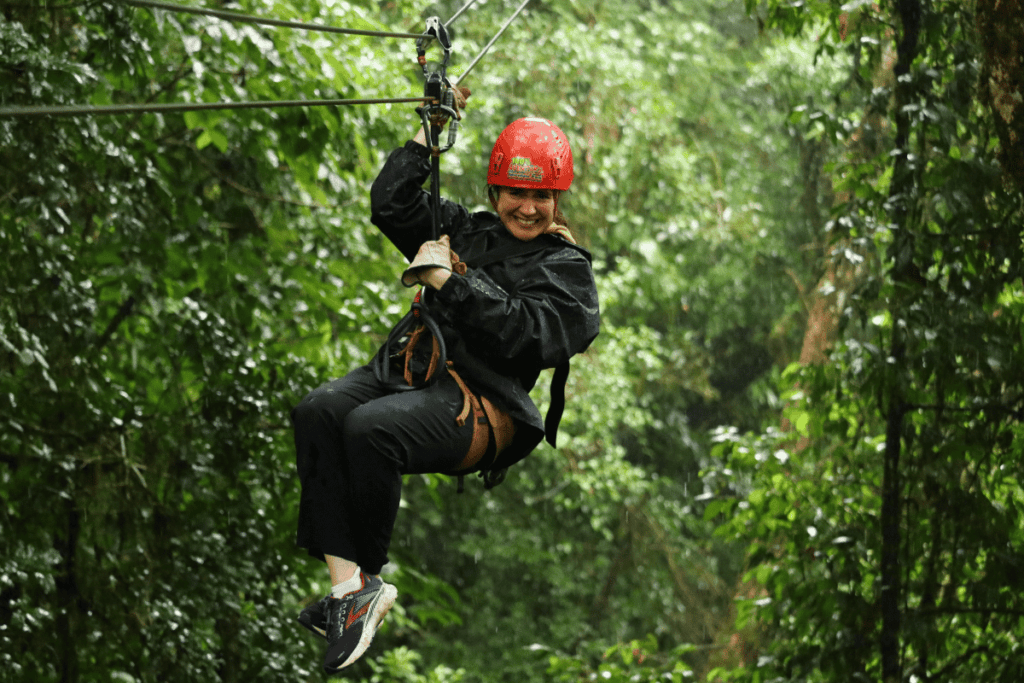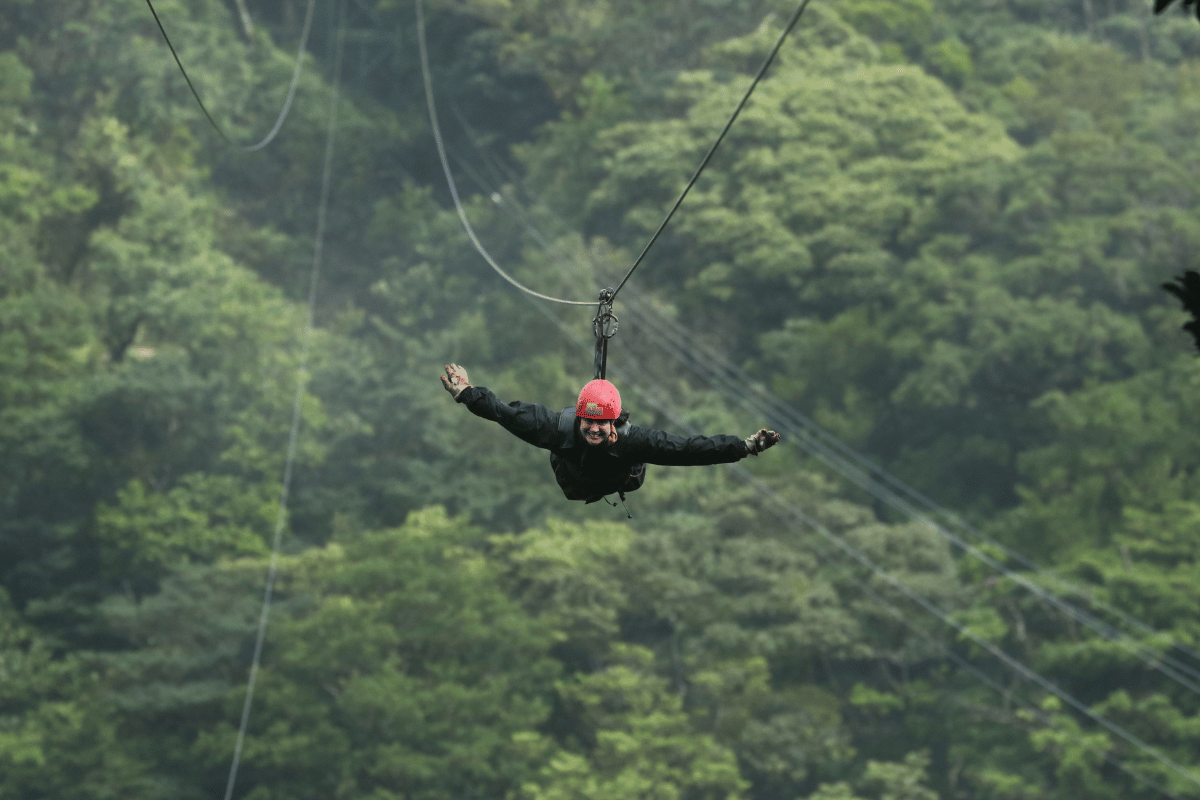Yay! I’m so very excited that you are planning your first trip to Costa Rica. It’s such an amazing country with SO much to see and do! However, I know that the initial planning steps can be a bit overwhelming. Not to worry! We are here to help. Here’s everything (yep, it’s a long read) to know before your first trip to beautiful Costa Rica.

Entry Requirements for US citizens
As a US Citizen or permanent resident, you don’t need a visa to travel to Costa Rica. Simply book your round-trip ticket and upon entering Costa Rica show the immigration your return ticket and hotel bookings.
Next, answer some basic questions about what brings you to Costa Rica and how long you will be visiting. Then the immigration official will stamp your passport which is good for a 180-day tourist visa.
However, you will need a valid passport that is valid for the length of your stay.
Keep in mind you can’t bring plants or fresh fruits and vegetables into Costa Rica because it could affect the natural habitat here.
Vaccines
Good news! You don’t need any extra vaccinations when coming to Costa Rica, according to the CDC. The CDC does recommend being up-to-date on all recommended vaccines in the US.
That said, the dengue virus is on the rise throughout primarily South America but Costa Rica is on the CDC’s list of affected areas. A vaccine isn’t recommended by the CDC for dengue. Instead, they recommend avoiding mosquito bites by using insect repellent, wearing long sleeves and pants, and sleeping under a mosquito net if staying outdoors.
Costa Rica Airports
There are two major international airports in Costa Rica, and they are located in San Jose and Liberia.
1. Juan Santamaría International Airport, San José, Costa Rica
San José is the capital city of Costa Rica and home to Costa Rica’s largest international airport, Juan Santamaría International Airport (SJO).
Even though SJO airport is very close to the capital city, it’s about a 30-minute drive from the heart of the capital. The town directly adjacent to the airport is called Alajuela. If your flight gets in late, it is better to get a hotel or Airbnb in Alajuela rather than in San Jose.
Most tourist destinations are easily accessible from the hub of San Jose. You can easily find transportation to popular Costa Rican towns like Manuel Antonio, La Fortuna, or Monteverde.
2. Daniel Oduber Quirós International Airport (LIR), Liberia, Costa Rica
Daniel Oduber Quirós International Airport, or easier said, Liberia International Airport (LIR) is a popular airport that tourists fly into when they want to head straight to the beach. That’s because LIR is located a quick 1-2 hour drive from the popular beach towns of Tamarindo, Playa Flamingo, and Playa Hermosa.
If all you’re planning is a quick trip to the beach, it could be best to fly into Liberia Airport. It’s important to know that flights are generally more expensive going to LIR than SJO, but not always. Keep your eyes open for good deals!
Costa Rica Transportation

Your best option for transportation in Costa Rica will be totally unique to your personal preferences for your trip. Tourists can navigate the country by renting a car, using private or shared shuttles, or taking public transportation.
Renting a Car
Renting a car in Costa Rica is the best option for tourists who want the freedom to explore at their leisure. An advantage of renting a car is that you can go to places more off the beaten path and away from tourist hubs. That said, you need to be comfortable with driving in different conditions than what you would encounter in the US.
Private and Shared Shuttles
If you decide that driving isn’t for you, there are options to book either a private or a shared shuttle. Private shuttles will be the most expensive because they offer the convenience of door-to-door pickup at the time that is most convenient for you. Shared shuttles on the other hand have fixed pick-up and drop-off times and you need to go to a specific meeting place to board.
Public Transportation
Lastly, if you are a savvy traveler and have some ability to communicate in Spanish, you could try using the public transportation system in Costa Rica. This option is by far the cheapest but can be difficult to navigate. You may also face inconveniences, for example, needing to wake up at 5 AM to catch a bus to your next destination.
Choosing your preferred method of transportation will need to align with your length of stay, personal traveling preferences, and your Costa Rica trip budget.
Driving in Costa Rica
Driving in Costa Rica is a different experience from driving in the United States. There are several key differences.
| Motorcycles | There are a very large number of motorcycles and scooters on the roads in Costa Rica. The drivers on bikes weave through traffic, pass on all sides, and generally do not obey what we think of as ‘rules of the road’. Be mindful at all times of who is around you and know that motorcyclists can come up on either side at any time |
| Yeilding to Pedestrians | In Costa Rica, it’s not common for drivers to yield to pedestrians like is the rule in the US. If you’re a pedestrian you need to wait for a walk signal in the crosswalk. If there isn’t a crosswalk, you need to wait for cars to pass rather than expecting them to yield to you. |
| Stop Signs | You should obey stop signs in Costa Rica. You may sometimes see drivers come to a rolling stop especially if there is clearly no one coming from the other direction, but I always obey stop signs to be on the safe side. |
| Traffic Lights | Traffic lights in Costa Rica are only not obeyed late in the night when the roads are all but empty. During the day time, drivers almost always obey traffic lights and I certainly obey them when I drive in Costa Rica. |
| Merging onto the Highway | Be aware that you will often have a very short amount of space to merge so be aware of your surroundings and who is coming up behind you (especially motorcycle drivers). |
| Driving in Rural Areas or Mountains | Many people ask if they will need 4-wheel drive in Costa Rica. If you are planning a trip to a mountainous region in Costa Rica and have accommodations somewhere rural, you might need 4-wheel drive. Talk with the hotel staff or Airbnb host to learn if they think a 4-wheel drive vehicle will be necessary |
Other Tips for Driving in Costa Rica
- Use Google Maps or Waze to navigate around Costa Rica. Apple Maps will be useless here. Addresses are very different than in the US, you won’t see a house number or street name. Instead, put the name of your hotel or destination into Google Maps or Waze. If you’re having trouble with the navigation, contact the owner of your accommodations directly to find out the best way to get there.
- When driving in Costa Rica, bring some small bills in your car for tolls along the way. Most tolls are $1-2 but it’s best to have some of the local currency on hand. I’d suggest bringing 3-5 bills of the 1,000 colones (red in color).
- There will be places to stop for gas as you’re driving. Like in the US, you’ll see gas stations along the side of the highway. Or, if you’re running low on gas and don’t see one pull over at your next exit and put “gas” into Google Maps and you’ll see stations that are close by.
Languages in Costa Rica
The official language in Costa Rica is Spanish. Many individuals working in the tourism sector will speak English. That said, it’s a Spanish-speaking country and you can’t expect people will speak English wherever you go (unless you’re only staying at a resort).
You wouldn’t believe how often I hear tourists who become frustrated with Costa Rican workers who don’t speak English. Don’t be that tourist!
If you don’t speak Spanish, it can be helpful to learn some basic Spanish phrases before coming to Costa Rica such as hello, please, thank you, etc.
Currency
The currency in Costa Rica is the Costa Rican Colon. The exchange rate changes every day so you need to look online for the current rate before your trip.
The bills you will find in Costa Rica are:
| 1,000 colones | red color |
| 2,000 colones | blue color |
| 5,000 colones | yellow color |
| 10,000 colones | green color |
I don’t recommend getting bigger bills than 10,000 when you travel. You can also use credit cards almost anywhere you go. Visa or Mastercard will be accepted almost everywhere, and American Express is more commonly accepted across the country (but not always).
Best time to Visit Costa Rica

The rainy season in Costa Rica is from May until November. For that reason, December until April can be the best time to visit Costa Rica for dry weather. A caveat to this is that this is the busiest season of tourism in Costa Rica. The busiest weeks are around Christmas time and Semana Santa in March or April (look up which week it will be before booking travel).
If you want a dry beach vacation, travel during the months of December to April, and try to avoid the crowds around Christmas and Semana Santa. If you don’t mind the tropical rains and prefer to visit the tourist destinations when they are less crowded, I think May and November can be great months to visit Costa Rica.
Destinations Quick Guide:
Costa Rica is actually a pretty small country (slightly smaller than West Virginia). However, the landscape is diverse and the adventures are truly endless. Here’s a quick overview of the hot spots in the country!
Arenal Volcano/La Fortuna (Northwest)
- Distance from San Jose: 118 km (2.5 hours)
- Distance from Liberia: 134 km (2 hours 25 minutes)
Arenal is a towering active volcano famous for its other-worldly hiking trails, beautiful lake for kayaking, and adventurous activities like ziplining, hot springs, and waterfalls.
Caribbean Coast:
- Distance from San Jose: 240 km (4 hours)
- Distance from Liberia: 436 km (7 hours)
The relaxing, laid-back feeling and beautiful beaches along the Caribean coast draw travelers to destinations like Puerto Viejo, Cahuita, and Punta Uva. Try taking a horseback ride on the beach or doing a chocolate tour in the jungle. Also don’t forget to try the famous Caribbean rice and beans dish while you’re there!
Guanacaste and Pacific Beaches:
- Distance from San Jose: 231 km (4 hours)
- Distance from Liberia: 37 km (1 hour)
Tourists come from all over the globe to experience the beautiful white sand beaches on the Pacific coast of Costa Rica, like Playa Hermosa, Playa del Coco, Playa Flamingo, and Tamarindo. In these destinations, you can relax on the beach or try a snorkeling tour to experience marine wildlife in the region.
Manuel Antonio National Park:
- Distance from San Jose: 159 km (2 hours 45 minutes)
- Distance from Liberia: 260 km (4 hours)
Manuel Antonio Park is a top tourist destination for the diverse wildlife found on the beaches and dense jungle there. With the help of a certified tour guide, you can experience viewing wildlife such as sloths, monkeys, bats, insects, exotic birds, and more. Just be careful leaving your stuff unattended at the beach because the monkeys will steal your things (seriously).
Monteverde:
- Distance from San Jose: 134 km (2.5-3 hours)
- Distance from Liberia: 114 km (2 hours)
Imagine ziplining above the clouds overlooking a beautiful mountainous, rainforest teaming with wildlife, and a quaint town where you can find coffee shops selling coffee sourced directly from growers in the region. You’ve made it to Monteverde!
San Jose & Central Valley:
- Distance from Liberia: 199 km (3 hours)
You may want to spend a morning or an afternoon in San Jose to do a walking tour, learn about the history of Costa Rica, and see the capital city. Visit the central market to buy coffee beans, handmade goods, and fresh fruits and vegetables. Don’t miss La Sorbetera Lolo Mora for a cone of their famous “crema” flavored ice cream!
Costa Rica Budget (+ tips for saving money)
Costa Rica is not necessarily a budget-friendly vacation. It’s actually one of the most expensive countries in Latin America. With some upfront planning, you can experience the beauty of Costa Rica on a budget.
Here are some tips to help you make the most of your adventure while saving money.
- Plan a trip during the off-season – If you don’t mind the tropical rains, you can plan a visit during Costa Rica’s off-season between May and November. Prices for accommodations and flights are cheaper during the rainy season in Costa Rica.
- Book in advance – Before you leave, have it mapped out where you plan to go each day. Purchase tours, national park entry fees, and excursions in advance to have a more complete picture of what you expect to spend.
- Try a self-guided tour – Tour guides are a must at popular wildlife parks such as Manuel Antonio because they will point out amazing wildlife you won’t see otherwise. That said, there are some adventures you can book without a guide, such as visiting the Poas Volcano or La Fortuna Waterfall.
- Eat at ‘sodas’ – Sodas are restaurants with typical Costa Rican food that have a lower price tag than restaurants marketed for tourists. Not only is the food delicious, but you can expect to spend $8-10 at a soda for a well-portioned meal.
- Brave public transport – If you’re adventurous and travel savvy, you can try taking public transportation around Costa Rica. Bus tickets cost anywhere between $5-15 one way. It’s recommended you know some basic phrases in Spanish if you decide to take the bus in Costa Rica
Costa Rica is a more expensive country than some of its neighbors in Central America, but you can come to Costa Rica without breaking the bank with some advanced planning.
Cellphones in Costa Rica
When you enter Costa Rica, it is indispensable to have a working cellphone. That’s because you’ll need your phone to help you navigate around the country, communicate using translation apps, and make calls in the event of an emergency. There are a few ways to ensure you have working cell service in Costa Rica.
Check with your carrier to see if they offer an international roaming plan. While some providers include international travel in their service, many charge a daily fee to keep your phone working (usually about $10/day but check with your carrier).
Another option is to buy a physical SIM card when you get to Costa Rica. Local providers in Costa Rica are Kolbi (ICE), Claro, and Movistar and there is a Claro kiosk in the airport where you can purchase a SIM card on arrival. This is a good option for budget travelers who prefer not to pay for an international plan.
Wi-Fi access is pretty well spread across Costa Rica. Most hotels, restaurants, and public places will have available Wi-Fi. However, while you are out and about you’ll need data to get your phone to work.
Costa Rica Safety
While Costa Rica is generally considered a safe country for tourists, it’s important to take basic precautions to stay safe when traveling in Costa Rica.
- Avoid walking alone in major cities after dark – Walking alone after dark is never a great idea when traveling anywhere, but it’s not a good idea to be out in major cities like the capital of San Jose after dark by yourself.
- Keep valuables stored – When you’re out doing excursions, you should keep valuables and your passport back in the hotel. Try to keep money in a crossbody back and avoid carrying large amounts of cash.
- Used licensed transportation services – Only use licensed red taxis with a yellow triangle rather than unmarked cars. Uber is not legal in Costa Rica but the app is widely used, especially in San Jose.
- Be sure your phone works – As mentioned above, having a working phone is needed for safety reasons. You need to be able to access translation services, navigation, or emergency phone calls if needed.
- Take health precautions – Wear bug spray or long sleeves to protect against mosquito bites, drink plenty of water, and use sunscreen in sunny areas
- Wildlife safety – Only stick to marked trails and never interact directly with wildlife. There are venomous snakes in Costa Rica and you should never approach them, or other wild animals, without a trained guide.
- Get travel insurance – Travel insurance is a way to protect yourself if you have trip delays, your bag gets lost, or you have a medical emergency while abroad.
By taking these precautions, you can enjoy the beauty of Costa Rica while staying safe at the same time!
My Tips for Your First Time in Costa Rica

Your first trip to Costa Rica is sure to be a magical one! My biggest advice when you visit Costa Rica for the first time is to have a plan, but also build some flexibility into your schedule so you can be spontaneous. You’re going to want to have some amazing tours lined up, but also have the freedom to explore independently when you want.
I have a few last-minute tips for when you’re traveling to Costa Rica for the first time.
- Learn basic Spanish – Some basic Spanish phrases will go a long way when you’re in Costa Rica. “Pura vida” is a phrase you’ll hear a lot in Costa Rica! It’s a phrase that has a lot of meanings like hello, goodbye, thank you, and I’m doing well. Know when you hear “pura vida” in Costa Rica, they’re wishing you well!
- Download WhatsApp – It’s indispensable to download WhatsApp while in Costa Rica because so many businesses use WhatsApp to communicate. That means instead of calling businesses from your US number and facing roaming charges, you can simply download WhatsApp and make a call or send a message while you’re connected to Wi-Fi.
- Expect some rain – Even if you visit Costa Rica in the dry season from December to April, you may still experience some rain because Costa Rica is a tropical country! Bring rain gear and a plastic ziplock bag for your phone in the event you get caught in a rain storm.
- Get out of your comfort zone – Making the most of your first trip to Costa Rica is all about being flexible and going with the flow! You might have everything planned out perfectly but things will come up that alter your plans. There might be a rain shower, an amazing view you want to pull over and check out, or a Spanish-only speaking restaurant you’d like to try, despite not having strong skills yet. Relaxing and enjoying your trip even if there are changes to your plan will ensure you have the best trip possible.
You’ll never forget your first trip to Costa Rica. There is so much to experience from diverse wildlife, white sand beaches, and lush rainforests. Embrace the “pura vida” lifestyle and have an amazing adventure!

Lindsay Gantz lives in Monteverde, Costa Rica with her husband who is Costa Rican. She helps visitors plan trips to Costa Rica and also organizes small group trips for solo female travelers. You can reach her on Instagram or by email at [email protected]

